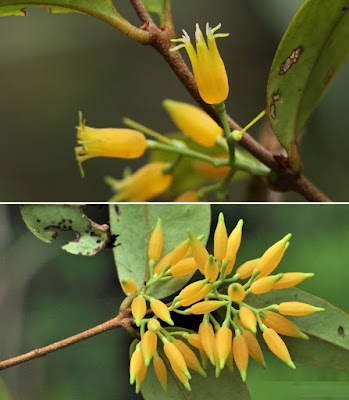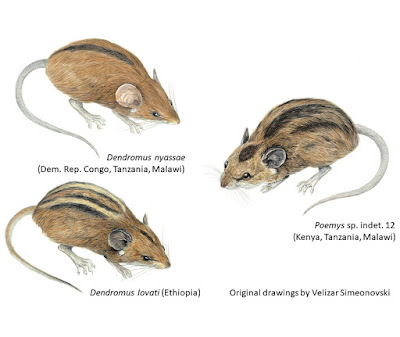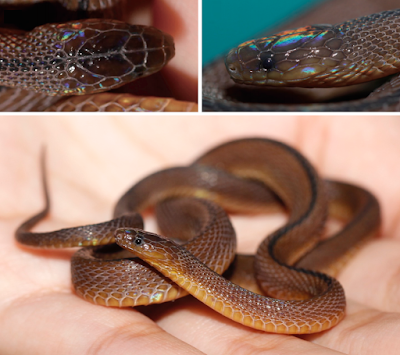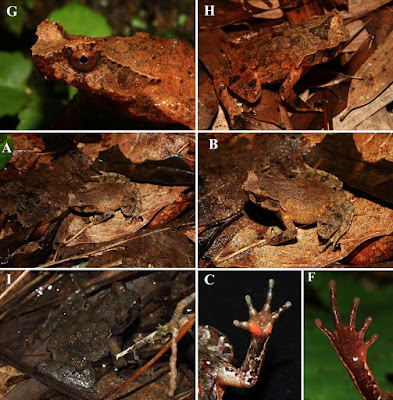[Most Recent Entries] [Calendar View]
Monday, June 7th, 2021
| Time | Event | ||||
| 3:01a | [Botany • 2021] Amylotheca cleofei (Loranthaceae) • A New Species and Genus Record for the Philippines
Abstract A new mistletoe species, Amylotheca cleofei, from Mount Hamiguitan Range Wildlife Sanctuary, Davao Oriental in the southern Philippines, is herein described and illustrated, representing a new species and genus record for the country. This species differs from other known Amylotheca species in terms of its distinctive reproductive and vegetative characters. Keywords: endemic, Eudicots, Malesia, Mindanao, Santalales, taxonomy Danilo N. Tandang, John Michael M. Galindon, Noel E. Lagunday, Fulgent P. Coritico, Victor B. Amoroso and Alastair S. Robinson. 2021. Amylotheca cleofei sp. nov. (Loranthaceae), A New Species and Genus Record for the Philippines. Phytotaxa. 507(1); 113–120. DOI: 10.11646/phytotaxa.507.1.7 | ||||
| 3:42a | [Mammalogy • 2021] Molecular Systematics and Biogeographic History of the African Climbing-mouse Complex (Dendromus)
Highlights: • Climbing-mice are widely distributed across sub-Saharan Africa. • Extensive sampling of species and localities reveals 14 cryptic taxa. • Six other taxa are identified as likely synonymized species. • B Distributions suggest considerable ability of climbing-mice to colonize new areas. Abstract Climbing mice in the genus Dendromus (sensu lato) are widely distributed in Africa, south of the Saharan Desert. The 17 currently recognized species in the genus range from widespread taxa to single-mountain endemics, and there is considerable variation across species with respect to habitats occupied. These habitats range from arid grasslands and savannahs to sub-alpine and alpine vegetation. Using the most comprehensive geographic and genetic survey to date and after reviewing many type specimens, we assess the systematics and biogeography of Dendromus. Given the structure of our molecular phylogenetic hypotheses, in which we recover six major clades, we propose the recognition of three genera within the Dendromus group (sensu lato): in addition to Dendromus (26 lineages), we suggest the retention of Megadendromus (monotypic) and the resurrection of the genus Poemys (six lineages). From our model-based molecular phylogenetic results and morphological comparisons, we suggest that six formerly synonymized taxa should be resurrected, and we highlight 14 previously undescribed lineages. We also constructed time-calibrations on our phylogeny, and performed ancestral area reconstructions using BioGeoBEARS. Based on fossil evidence, Dendromus appears to have had a widespread African distribution dating back to the Late Miocene (8–10 Ma), and our basal ancestral area reconstruction (Ethiopians Highlands + Eastern African Mountains + Zambezian region) supports this. Divergence of the six major clades we recover (Poemys, Megadendromus and four within Dendromus) occurred prior to or at the Miocene-Pliocene boundary 5.3 Ma. Biogeographically, Megadendromus is restricted to the Ethiopian Highlands. The ancestral area for Poemys is reconstructed as the Zambezian region, with species distributions ranging from South Africa to Western Africa. The ancestral area for Dendromus is reconstructed as the Ethiopian Highlands, with the ancestral areas of the four major clades being reconstructed as Ethiopian Highlands, Albertine Rift, South Africa or Western Africa. None of the four Dendromus clades are reciprocally monophyletic with respect to distributional area. Keywords: Africa, Climbing mice, Dendromus, Dispersal, Phylogeny, Vicariance G. Voelker, J.W. Huntley, J. Bryja, C. Denys, R. Šumbera, T.C. Demos, L. Lavrenchenko, V. Nicolas, T.P. Gnoske and J.C. Kerbis Peterhans. 2021. Molecular Systematics and Biogeographic History of the African Climbing-mouse Complex (Dendromus). Molecular Phylogenetics and Evolution. 161, 107166. DOI: 10.1016/j.ympev.2021.107166 | ||||
| 4:40a | [Herpetology • 2021] Achalinus huangjietangi • A New Species of the Genus Achalinus (Serpentes : Xenodermidae) from Huangshan, Anhui, China
Abstract: A new species of the genus Achalinus is described based on five specimens collected from the villages of Huangjialing and Fuxi, Huangshan, Anhui, China. It can be morphologically differentiated from all the other species in Achalinus except for A. spinalis and A. werneri by the presence of a dotted black streak in the middle of the subcaudal. It can be distinguished from A. spinalis in that its two anterior temporals are in contact with eye, and A. werneri by its light brown flanks. The phylogenetic relationship of Achalinus was reconstructed using the mitochondrial locus of cytochrome c oxidase subunit 1 (CO1). The five new specimens form a monophyletic clade with strong support. The uncorrected p-distances between the new species and other representatives of Achalinus range from 13.6% to 21.7%. The recognition of the new species increases the number of described Achalinus species to 14. Keywords: Achalinus huangjietangi sp. nov.; Huangjialing Village; morphology; molecular phylogeny; taxonomy Achalinus huangjietangi sp. nov. Ruyi HUANG, Lifang PENG, and Song HUANG Suggested English name: Huang’s Odd-scaled Snake. Suggested Chinese name: 黄家岭脊蛇 (Bopomofo: Huáng Jiā Lǐng Jǐ Shé). Diagnosis: The new species of Achalinus tha t can be differentiated from its congeners by the following combination of characters: an iridescent, black (in juveniles) or brown (in adults) dorsum with vertebral scales and about half of the adjacent dorsal scales dark, forming a longitudinal vertebral line from posterior margin of parietals to tail tip, a light brown venter, ventral shields wide and visible on both sides, light brown flanks, a black dot in the middle of each subcaudal scale, giving the appearance of a black subcaudal streak, dorsal scales weakly keeled and do not overlap, 23 dorsal scale rows throughout the body, outermost dorsal row smooth and significantly enlarged, preocular and postocular absent, an internasal suture half of the length of the prefontal suture, temporals 2+2+4, elongated with the two anterior temporals in contact with eye, a pair of significantly enlarged uppermost posterior temporals (super-temporal) separated from each other by a small intertemporal behind the parietals. Etymology: The species name is derived from the name of Professor Jietang Huang (Huangshan Institude of Ophiology), a senior ophiologist who has been contributing substantially to snake researche over 50 years. Born and raised in Huangjialing Village, he was the first college graduate from the village. Natural History: Specimens were found in secondary conifer/ broad-leaved mixed forests (Figure 1) at elevations from 220 to 450 m a. s. l. Achalinus huangjietangi sp. nov. is a nocturnal, secretive and subterranean snake, living in the forest floor, and is usually hidden in deciduous and humic layers close to streams and ditches. Ruyi Huang, Lifang Peng, Lei Yu, Tianqi Huang, Ke Jiang, Li Ding, Jinkang Chang, Diancheng Yang, Yuhao Xu and Song Huang. 2021. A New Species of the Genus Achalinus from Huangshan, Anhui, China (Squamata: Xenodermidae). Asian Herpetological Research. 12(2); 1-10 . DOI: 10.16373/j.cnki.ahr.200075 黄家岭脊蛇—安徽师范大学生命科学学院发现蛇类新物种 | ||||
| 10:28a | [Herpetology • 2019] Megophrys ombrophila • A New Species of the Genus Megophrys Gunther, 1864 (Anura: Megophryidae) from Mount Wuyi, southeastern China
Abstract A new species of horned toad, Megophrys ombrophila sp. nov., is described based on specimens found from Guadun village from Mount Wuyi in northwestern Fujian Province, China. The species is distinguished from other described Megophrys by morphology, bioacoustics, and molecular data of the 12S and 16S mitochondrial loci. The species is characterized by its rotund stature, head length approximately equal to head width, canthus rostralis well developed, tympanum large and distinct, vomerine teeth absent, margin of tongue smooth, not notched from behind, heels of the feet not meeting when femurs are held at 90° to the axis of the body and tibias are depressed against the femur, toes weakly webbed at base, dorsal skin mostly smooth with scattered granules and ridges, usually the presence of two discontinuous dorsolateral ridges, supratympanic fold distinct and well-developed, and with females ranging from 32.8–35 mm snout-to-vent length, and males ranging from 27.4–34.5 mm SVL. In its type locality, the species is sympatric with M. boettgeri and M. kuatunensis; and phylogenetically, the most closely related described species is M. obesa from southwest Guangdong province. As more cryptic species are described within the subfamily Megophryinae, the more apparent becomes the need for fine-scale molecular and phenotypic assessment to capture the many forms of this hyper-diverse group. Keywords: Amphibia, Anura, Megophryidae
Megophrys ombrophila sp. nov. Messenger & Dahn Etymology. Megophrys ombrophila: Greek: ombros (rainstorm), Greek: philos (that loves, that is fond of), in reference to the species’ propensity for being especially active during and after heavy rainstorms. For an English and Chinese standard name, we are recommending the name Yu Shen Horned Toad/ Yǔ Shén jiǎo chán (雨神角蟾), after the Chinese god of rain. Kevin R. Messenger, Hollis A. Dahn, Yuanrui Liang, Peng Xie, Yong Wang and Changhu Lu. 2019. A New Species of the Genus Megophrys Gunther, 1864 (Amphibia: Anura: Megophryidae) from Mount Wuyi, China. Zootaxa. 4554(2); 561–583. DOI: 10.11646/zootaxa.4554.2.9 |
| << Previous Day |
2021/06/07 [Calendar] |
Next Day >> |






















